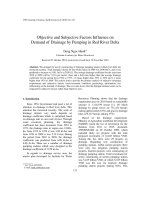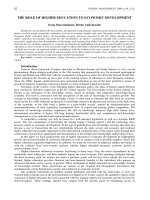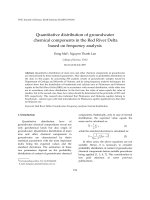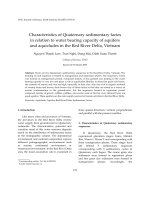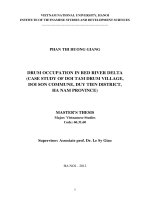Preliminary evaluation of impacts from science technologies to economic development of Red River Delta area
Bạn đang xem bản rút gọn của tài liệu. Xem và tải ngay bản đầy đủ của tài liệu tại đây (195.3 KB, 8 trang )
JSTPM Vol 2, No 4, 2013
45
PRELIMINARY EVALUATION OF IMPACTS
FROM SCIENCE-TECHNOLOGIES TO ECONOMIC
DEVELOPMENT OF RED RIVER DELTA AREA
M.Sc Tran Anh Tuan
Institute of Regional Research and Development, MOST
Abstract:
The paper has targets to evaluate impacts from science and technology (S&T) to economic
development of Red River Delta area through interactive relations between indicators
reflecting S&T activities. The evaluation is based on integrated approaches and selections
of related factors. Particularly in this paper, the research team conducted the separate
evaluations of S&T factors from many other factors. By using iterative functions for
identification of these relations, the study helps to identify the rate of impacts from these
factors and then to identify orientations to adjust them in order to enhance the effectiveness
of economic development.
Keywords: Evaluation of impacts; Science and technology; Economic development; Red
River Delta.
Code: 13122701
1. General introduction
There exist, up to now, very few research works related to evaluations of
impacts from S&T to economic development. Some of them deal only with
global views and qualitative assessment of the matter, rather than
quantitative assessment. They did not yet indicate the way the actual S&T
activities impact the economic development and the rate of these impacts.
In order to have a full picture of S&T activities and economic development
of Red River Delta area, various indicators may be listed out and they can
be presented in absolute or average figures. Every indicator reflects one or
few aspects of S&T activities or economic development. The full picture
should be based on analysis of many, as more as possible, various indicators
which reflect all the aspects of the research problem. From another side,
however, a large number of indicators would make the problem too complex
and then the analysis may be spread out. Many indicators might be
overlapping, not easy to be collected in practice, and even in some
circumstances the collected data are not highly trusted. For study of impacts
from S&T activities to economic development of Red River Delta area, we
could not get indicators which reflect directly these relations and could not
46
Preliminary evaluation of impacts from science-technologies…
also to define how much a unit can get benefits from expenditures for S&T
activities. We need, therefore, to build related factors to compute specific
indicators for science-technology and economic development separately,
then to apply mathematical models to study relations, to evaluate interactive
trends between them. The research team of the project Application of
methods of parameter assessment combined with eco-mathematical models
(production functions) to express the relations between the productivities
and input factors.
Therefore, the evaluation of impacts from S&T factors to the economic
growth of Red River Delta area would contribute to make proposals of
policies for effective use of resources and objectives of sustainable
development.
2. Research methodologies
On basis of research objectives, in order to get data for iterative analysis of
interactive relations between S&T activities and economic development in
Red River Delta area, the research team conducted the collection of data
related to necessary indicators of every cities and provinces in Red River
Delta area.
Also, on basis of actual situations of existing and available data from
management practice, we selected the most specific indicators for S&T
activities and economic development.
2.1. Specific indicators of S&T activities
They are divided into two groups: statistic indicators of labor qualities and
statistic indicators of technological capacities.
- Group of statistic indicators of labor qualities include the rate of labors
by technical qualification level and the average number of years of
education for labors from 18 years old age up.
- Group of statistic indicators of technological capacities is divided into 3
sub-groups:
Sub-group of indicators of technological innovations: Average
investment capital for a labor and the evaluation score of
technological level.
Sub-group of indicators of technology transfer: Rate of foreign direct
investment (FDI) to the total investment capitals and the average fixed
asset value of a labor and the average energy power consumption by
person.
JSTPM Vol 2, No 4, 2013
47
Sub-group of indicators of information technologies: The number of
telephone subscibers, number of computers by person, and some other
indicators such as the number of units equipped with LAN, Website
and e-trade.
The above noted indicators are converted to corresponding specific values,
then to average values to produce the specific indicators of qualities of
labor, technological innovations, technology transfer and information
technologies. Finally, the average figures of these indicators are the S&T
specific indicators.
2.2. Specific indicators of economic development
Labor productivity (based on added values): Average incomes by person
and benefit rate, export rate, budget collection-expenditure rate.
Every above noted corresponding indicators are converted to corresponding
specific values, then to average values to produce the specific indicators of
economic development.
3. Research results
On basis of collected data, the research team conducted calculations of
values, figures, and specific indicators of S&T activities and economic
development of Red River Delta area which are seen as follows:
3.1. Calculations of specific indicators of S&T activities
- Calculations of labor quality from data of rates of technically qualified
labors:
Table 1. Indicator of labor quality
No Cities/Provinces
Indicato
Rank
r (%)
No
Cities/Province Indicato
Rank
s
r (%)
1
Hanoi
77.34
1
7
Hai Phong
45.85
2
2
Quang Ninh
39.86
3
8
Hung Yen
26.66
10
3
Vinh Phuc
16.31
12
9
Thai Binh
27.47
8
4
Bac Ninh
29.51
7
10 Ha Nam
26.75
9
5
Ha Tay (former)
31.81
5
11 Nam Dinh
31.03
6
6
Hai Duong
24.08
11
12 Ninh Binh
33.55
4
Source: Statistical Yearbook of cities/provinces and calculations/processing of survey data
by the research team.
Preliminary evaluation of impacts from science-technologies…
48
- Calculations of indicators of technological capacities:
Indicator of technological innovation is calculated on basis of budget
expenditures for S&T activities.
Indicator of technology transfer is calculated on basis of data on the rates of
FDI to the total investment capitals, the rates of attraction of investments
and the volume of power consumption by person.
Indicator of information technologies and communication is calculated on
basis of the score of computer use by person and the number of operating
telephone subscribers.
Table 2. Indicators of technological capacities
Unit: %
Ind. of
tech.
No Cities/Provinces
capacities
Ind. of
tech.
innovat.
Ind. of
tech.
transfer
Ind. of IT
and
commun.
Rank
1
Hanoi
69.45
67.17
68.37
70.83
1
2
Quang Ninh
50.93
40.97
50.86
53.47
4
3
Vinh Phuc
50.14
44.10
56.16
47.14
5
4
Bac Ninh
51.43
46.08
54.29
50.63
3
5
Ha Tay (former)
39.66
27.05
33.90
47.13
12
6
Hai Duong
48.12
36.45
50.42
49.31
6
7
Hai Phong
56.66
49.44
55.93
59.01
2
8
Hung Yen
45.27
41.45
46.69
45.17
8
9
Thai Binh
40.38
37.60
34.44
45.53
11
10 Ha Nam
46.70
35.38
42.47
52.71
7
11 Nam Dinh
40.82
32.53
36.30
46.27
10
12 Ninh Binh
41.00
39.47
37.26
44.18
9
Source: Statistical Yearbook of cities/provinces and calculations/processing of survey data
by the research team.
3.2. Calculations of specific indicators of economic development
- On basis of average GDP figures by person, GDP growth speed, export
rates and budget collection the specific indicators of economic development
are calculated and the results are presented in Table 3.
JSTPM Vol 2, No 4, 2013
49
Table 3. Common indicator of economic development
Comm. Ind. of ave. Ind. of
growth
No Cities/Provinces ind. of ec. GDP by
dev.
person
speed
Ind. of
export
rate
Unit: %
Ind. of
budget Rank
collect.
1
Hanoi
65.81
79.91
56.48
36.94
85.13
1
2
Quang Ninh
58.24
54.12
64.59
45.67
66.33
2
3
Vinh Phuc
50.15
40.10
77.22
12.57
53.69
4
4
Bac Ninh
40.81
40.67
69.41
10.68
13.99
5
5
Ha Tay (former)
28.95
28.73
49.16
8.16
9.76
9
6
Hai Duong
36.79
39.69
54.39
9.83
22.74
7
7
Hai Phong
56.12
56.69
55.10
36.96
76.19
3
8
Hung Yen
39.62
37.96
61.35
21.69
17.42
6
9
Thai Binh
26.79
29.16
36.19
12.86
17.17
11
10 Ha Nam
28.45
26.14
45.61
12.97
14.24
10
11 Nam Dinh
25.68
25.86
36.43
15.26
14.24
12
12 Ninh Binh
30.73
23.26
59.32
5.51
13.72
8
Source: Statistical Yearbook of cities/provinces and calculations/processing of survey data
by the research team.
3.3. Evaluation of impacts from science-technology to economic
development
From the outcomes presented in Tables 1, 2 and 3 we can make comparison
of the levels of technical qualification, technological capacities and
economic development between cities and provinces as follows:
Table 4. Common indicators of labor qualities, technological capacities and
economic development
No. Cities/Provinces
Labor qualities
Technological
capacities
Economic
development
Ind. (%) Rank Ind. (%) Rank Ind. (%) Rank
1
Hanoi
77.34
1
69.45
1
65.81
1
2
Quang Ninh
39.86
3
50.93
4
58.24
2
3
Vinh Phuc
16.31
12
50.14
5
50.15
4
4
Bac Ninh
29.51
7
51.43
3
40.81
5
5
Ha Tay (former)
31.81
5
39.66
12
28.95
9
Preliminary evaluation of impacts from science-technologies…
50
Technological
capacities
Labor qualities
No. Cities/Provinces
Economic
development
Ind. (%) Rank Ind. (%) Rank Ind. (%) Rank
6
Hai Duong
24.08
11
48.12
6
36.79
7
7
Hai Phong
45.85
2
56.66
2
56.12
3
8
Hung Yen
26.66
10
45.27
8
39.62
6
9
Thai Binh
27.47
8
40.38
11
26.79
11
10 Ha Nam
26.75
9
46.70
7
28.45
10
11 Nam Dinh
31.03
6
40.82
10
25.68
12
12 Ninh Binh
33.55
4
41.00
9
30.73
8
Source: Calculations by the research team
It is possible to present the indicators of labor qualities, technological
capacities and economic development in graphics (the absciss presents the
cities/provinces from 1 to 12, the ordinates presents the values of indicators)
as follows:
Labor qualities
Technological capacities
Economic development
90
80
70
60
50
40
30
20
10
0
1
2
3
4
5
6
7
8
9
10
11
12
Scheme 1. Common indicators of labor quality, technological capacities and
economic development respectively.
By analysis of the data in Table 4 and the graphic lines in Scheme 1, we can
note that globally the cities/provinces which have high values of the
indicators of labor qualities and technological capacities have also high
values of the indicator of economic development and inversely. Of course,
there are some exclusive cases, namely Hai Phong City and Thai Binh
Province. The relations between the labor qualities, technological capacities
and economic development are proportional and present the global and
interactive trends.
JSTPM Vol 2, No 4, 2013
51
On basis of available data we can conduct the iterative analysis for
correlations between the three indicators where the indicator of economic
development is the dependent variable noted as Y, the indicator of labor
quality is the first independent variable noted as X1 and the indicator of
technological capacities is the second independent variable noted as X2.
Applying the linear model for assessment of the correlations we can obtain
the formulas between them as follows:
- Correlation between the labor qualities (X1) and the economic
development (Y)
Yx1 = 21.21 + 0.57X1
- Correlation between the technological capacities (X2) and the economic
development (Y)
Yx2= - 28.90 + 1.44X2
Calculations give also the specific factors of tough relations between Y and
X1; between Y and X2 as follows:
- Between X1 and Y: Rx1y = 0.6411
- Between X2 and Y: Rx2y = 0.8878
4. Conclusions
On basis of data and graphic presentations of the indicators of labor
qualities, technological capacities and economic development and,
particularly, the calculations of iterative equations and factors of relations
we can make the following conclusions.
The outcomes of research show that the both factors of labor qualities and
technological capacities cause considerable impacts on economic
development. We can note also that the cities and provinces in Red River
Delta area which have higher level of labor qualities and technological
capacities would potentially have higher results of economic development.
We can note also that the technological capacities cause stronger impacts to
economic development than the labor qualities do. Namely, the factor of
correlations between the technological capacities and the economic
development (Rx2y = 0.8878) is superior to the one between the labor
qualities and the economic development (Rx1y = 0.6411).
The evaluation of impacts from S&T activities to economic development is
a highly necessary work which covers the large scope and contents of
research space. Therefore, on basis of this grassroot level research project,
we would like to make a proposal to make, in coming years, research
Preliminary evaluation of impacts from science-technologies…
52
projects of higher level to evaluate the impacts from S&T activities to
economic development in a more detail and concrete manner for individual
sectors of regional scale./.
REFERENCES
1.
Tang Van Khien. (2007) Method of calculation of common indicators of economic
development for the whole national economy. Bulletin Statistic Science. No. 03/2007,
p. 41.
2.
Tang Van Khien. (2008) Method of calculation of common indicators of technological
capacities. Bulletin Statistic Science. No. 02/2008, p. 1.
3.
Tang Van Khien. (2008) Iterative analysis of interactive impacts between S&T
activities and economic development through data of 84 processing industries Grade
IV. Bulletin Statistic Science. No. 03/2008, p. 1.
4.
Nguyen Van Ban, Tran Anh Tuan. (2008) Building the database of the socio-economic
and science-technology fields for the three key economic areas. Key ministerial level
research task. Center for Regional Research and Development.
5.
Tran Anh Tuan. (2013) Research for evaluation of impacts from S&T advances to food
production in Vinh Phuc Province. Grassroot level research project. Center for
Regional Research and Development.




